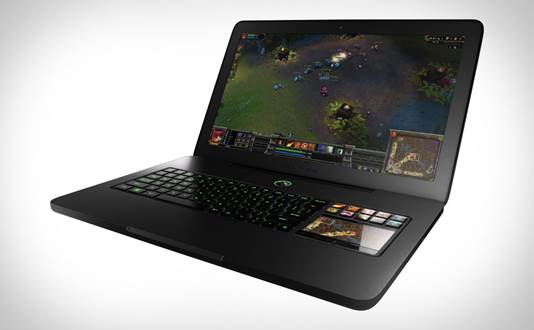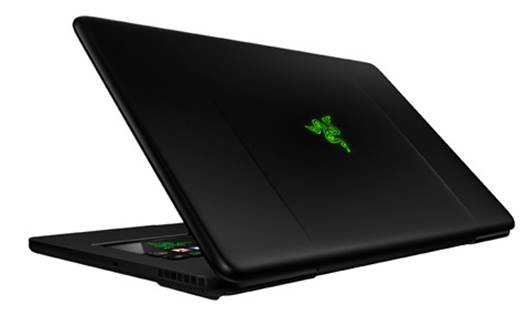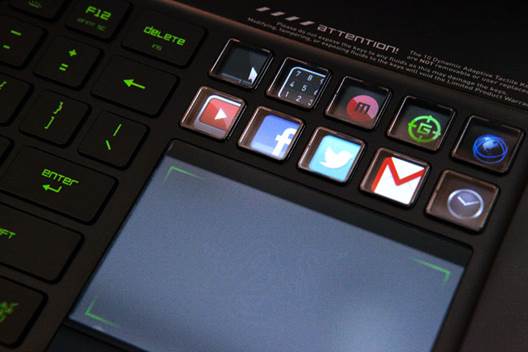GAMING LAPTOPS tend to push garish, over the
top designs these days; the second-generation Razer Blade throws these clichéd
conventions out the window. The result is a 16.8x10.9x.88-inch minimalist
laptop that resembles a large matte black MacBook Pro. This doesn’t mean the
Blade looks plain, however. Its alluring green LEDs coupled with its slick LCD
trackpad give this Blade a killer edge.
Featuring a 17.3-inch screen, the laptop is
massive. But, while the Blade certainly sports a Large footprint, it’s sexy slim
at .88 inches. While the laptop doesn’t feel tight with a carry weight of seven
pounds, seven ounces, ifs much Lighter than most competitors in its class.
Heck, our 15-inch MSI GT6O zero-point (reviewed Last month) was noticeably
heavier at 10 pounds.

Featuring
a 17.3-inch screen, the laptop is massive.
The brain behind the beauty is Intel’s
2.2GHz Core i7-36320M quad-core CPU which clocks up to 3.2GHz with Turbo Boost.
Discrete graphics come courtesy of Nvidia’s GeForce GTX 660M GPU with 2GB of
GDDR5 video memory. Unlike the MSI’s GTX 670, which uses the older 4Onm Fermi
architecture, the Blade’s GeForce is based on the 28nm Kepler chipset.
Regardless of the new architecture, the Blade’s 660 couldn’t match MSI’s 670
GPU, Losing to the latter by double-digit percentages in both our STALKER: Call
of Pripyat and 3DMark 11 benchmarks.
In our more CPU-intensive tests, the
Laptops traded bLow5. The GT6O’s 100MHz-faster 2.36Hz Core i7-36100M processor
performed slightly better in our Stitch.Efx 2.0 and ProShow Producer 5 tests,
but Lost to the Blades newer Intel CPU in our x264 benchmark by a slightly
wider margin. In terms of battery life, the Blade didn’t fare quite as well.
Looping an HO movie off the hard drive, the Blade’s 60 watt hour battery lasted
two hours and 44 minutes, compared to our zero point’s three plus hours. Of
course. machines of this size generally don’t travel far from a power outlet.

Of
course. machines of this size generally don’t travel far from a power outlet.
We’re more disappointed by the Blade’s
storage offering, which primarily consists of a 500GB HOD (that’s half what the
far-cheaper GT6O offers). But what the Blade lacks in capacity, it makes up for
in speed. Along with its 7,200rpm hard drive, the Blade features a 64GB SATA
6Gb/s SSO. As a result, the laptop booted to Windows in 24 seconds. Our
zero-point took more than twice as Long.
As for the screen, the laptop’s 1920x1080
LED-backlit LCD Looks great if you’re viewing it head-on, but it does have the
characteristic TN shimmer when you view it off axis. What really sets the
Laptop apart is its multitouch LCD trackpad. The mini panel Looks slick and
plays games surprisingly well. It’s certainly not as quick and precise as a
real mouse, but it’s about on par with an Xbox 360 controller for shooters. The
4-inch LCD screen also acts as a secondary 800x480 resolution monitor that s
aided by 10 programmable LCD buttons, allowing you to, say, watch YouTube
videos, check your Facebook page, or surf the web between loading screens. The
worst thing about the track pad is its placement on the right side of the
keyboard; because we’ve been conditioned to using a track pad below the
keyboard, having it on the right felt extremely counterintuitive and definitely
took getting used to but the placement does work better for gaming once you get
acclimated to it.

It’s
certainly not as quick and precise as a real mouse, but it’s about on par with
an Xbox 360 controller for shooters.
While the keyboard isn’t quite as unique,
its green LED-backlit keys Look gorgeous and we loved the quiet and responsive
feel of the buttons. One thing we didn’t Like about the keyboard and the whole
chassis, for that matter is its affinity for fingerprints. On the audio front,
the speakers are adequate they’re loud and don’t distort at full volume but
these run of the mill Laptop speakers aren’t going to impress audiophiles.

While
the keyboard isn’t quite as unique, its green LED-backlit keys Look gorgeous
and we loved the quiet and responsive feel of the buttons.
Although the Blade is by no means weak, for
a $2,500 gaming notebook, a better GPU would have been nice. Our zero point
GT6O, which is cheaper by $1,000, outperformed Razer’s laptop in several
benchmarks but is admittedly far bulkier and heavier. What you’re actually
paying for here is the design and portability. Luckily, the Blade delivers on
both fronts.